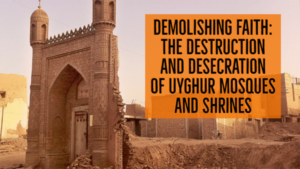Eighty-one years ago this week, in what is also known as the “Night of Broken Glass,” hundreds of synagogues and Jewish cemeteries in Nazi Germany were damaged or destroyed, along with thousands of Jewish-owned businesses. It was in a sense the starting gun for the genocide that culminated in the extermination camps of Auschwitz, Sobibor and Treblinka, notes Fred Hiatt.
In western China, the demolition of mosques and bulldozing of cemeteries is a continuing, relentless process. And — in possibly the most astonishing feature of this crime against humanity — China has managed to stifle, through 21st century repression and age-old thuggery, virtually any reporting from the crime scene, he writes for the Washington Post:
 Which makes all the more significant the publication last week of a heartrending compendium of evidence: “Demolishing Faith: The Destruction and Desecration of Uyghur Mosques and Shrines,” by Bahram K. Sintash…..Based on satellite imagery and interviews with recent exiles — escapees might be an apter term — Sintash estimates that 10,000 to 15,000 religious sites have been destroyed, he told a conference at the National Endowment for Democracy last week.
Which makes all the more significant the publication last week of a heartrending compendium of evidence: “Demolishing Faith: The Destruction and Desecration of Uyghur Mosques and Shrines,” by Bahram K. Sintash…..Based on satellite imagery and interviews with recent exiles — escapees might be an apter term — Sintash estimates that 10,000 to 15,000 religious sites have been destroyed, he told a conference at the National Endowment for Democracy last week.
Carl Gershman, president of the National Endowment for Democracy, likened the brave reporters of Radio Free Asia to Jan Karski, the Pole who tried to alert the West to Nazi atrocities, Hiatt adds. Those RFA reporters are living in exile, since China does not let them in, but dozens of their family members in western China have been imprisoned in retribution for RFA’s groundbreaking journalism on this cultural genocide. RTWT







